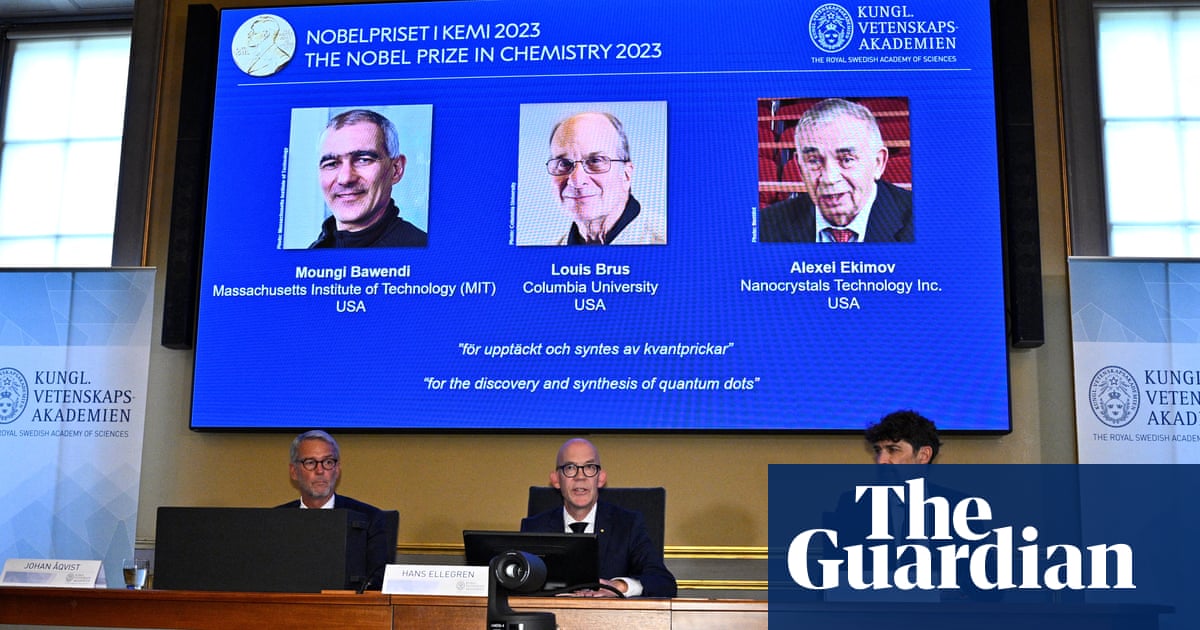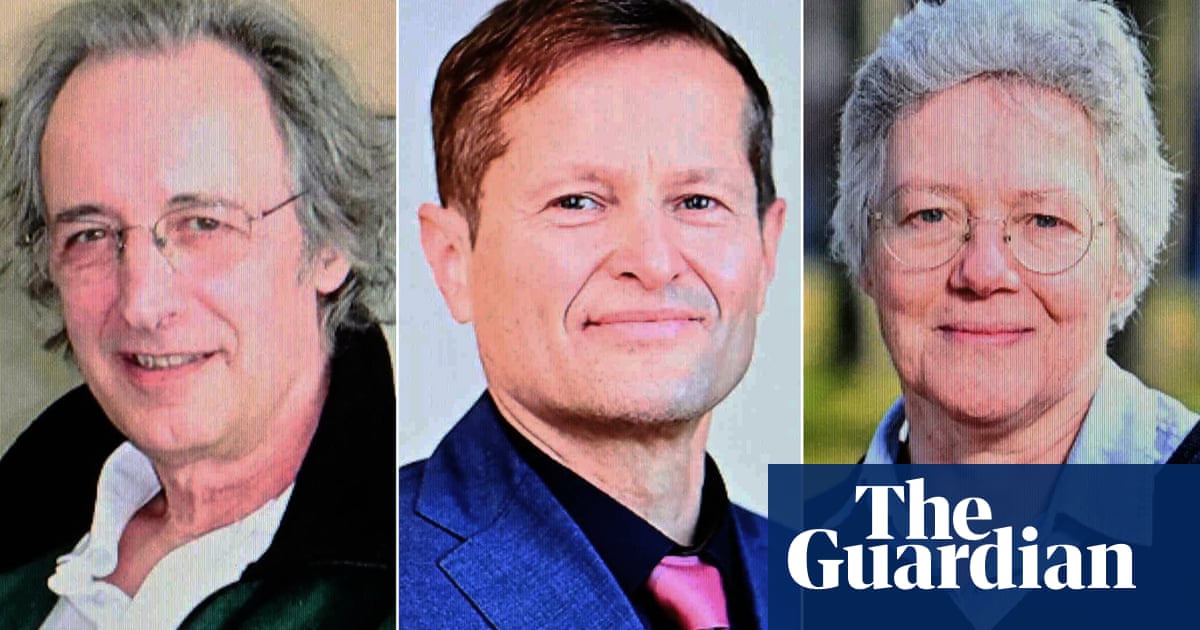
David Baker created a computer program called Rosetta that helped analyze information about existing proteins in comprehensive databases to build new proteins that don’t exist in nature
Demis Hassabis and John Jumper created an artificial intelligence model that has predicted the structure of virtually all the 200 million proteins that researchers have ever identified
LONDON: Three scientists who discovered powerful techniques to decode and even design novel proteins — the building blocks of life — were awarded the Nobel Prize in chemistry Wednesday. Their work used advanced technologies, including artificial intelligence, and holds the potential to transform how new drugs and other materials are made.
The prize was awarded to David Baker, a biochemist at the University of Washington in Seattle, and to Demis Hassabis and John Jumper, computer scientists at Google DeepMind, a British-American artificial intelligence research laboratory based in London.
Heiner Linke, chair of the Nobel Committee for Chemistry, said the award honored research that unraveled “a grand challenge in chemistry, and in particular in biochemistry, for decades.”
“It’s that breakthrough that gets awarded today,” he said.
What is the 2024 Nobel Prize in Chemistry for?
Proteins are complex molecules with thousands of atoms that twist, turn, loop and spiral in a countless array of shapes that determine their biological function. For decades, scientists have dreamed of being able to efficiently design and build new proteins.
Baker, 62, whose work has received funding from the National Institutes of Health since the 1990s, created a computer program called Rosetta that helped analyze information about existing proteins in comprehensive databases to build new proteins that don’t exist in nature.
“It seems that you can almost construct any type of protein now with this technology,” said Johan Åqvist of the Nobel committee.
Hassabis, 48, and Jumper, 39, created an artificial intelligence model that has predicted the structure of virtually all the 200 million proteins that researchers have ever identified.
The duo “managed to crack the code. With skillful use of artificial intelligence, they made it possible to predict the complex structure of essentially any known protein in nature,” Linke said.
Why does this work matter?
The ability to custom design new proteins — and better understand existing proteins — could enable researchers to create new kinds of medicines and vaccines.
It could also allow scientists to design new enzymes to break down plastics or other waste materials that would neutralize pollution, Baker told a news conference, or even come up with entirely new material for semi conductors.
“I think there’s fantastic prospects for making better medicines — medicines that are smarter, that only work in the right time and place in the body,” Baker told The Associated Press.
One example is a potential nasal spray that could slow or stop the rapid spread of specific viruses, such as COVID-19, he said. Another is a medicine to disrupt the cascade of symptoms known as cytokine storm.
“That was always the holy grail. If you could figure out how protein sequences folded into their particular structures, then it might be possible to design protein sequences to fold into previously never seen structures that might be useful for us,” said Jon Lorsch, a director at the NIH.
How did the winners react?
Baker told the AP he found out he won the Nobel during the early hours of the morning alongside his wife, who immediately started screaming.
“So it was a little deafening, too,” he said.
Hassabis said he was just having a “normal morning” at home when he eventually got the call.
The Nobel committee didn’t initially have his number and first managed to get hold of his wife, but she hung up on them a few times, he told an online news briefing.
“They kept persisting and then I think she realized it was a Swedish number and then they asked for my number,” he said.
“It’s so incredible. It’s so unreal at this moment,” said Jumper, a researcher and director at Google DeepMind. “And it’s wonderful.”
What was the role of AI?
One of Britain’s leading tech figures, Hassabis co-founded the AI research lab DeepMind in 2010, which was acquired by Google in 2014. Among its past breakthroughs was developing an AI system that mastered the Chinese game Go and defeated the game’s human world champion.
In the past researchers labored for months or years to decode the structure of a single complex protein.
But the AI model created by the DeepMind researchers, called AlphaFold, “can determine the structure of a protein pretty accurately within a few seconds or minutes,” Hassabis told the AP in an interview, adding that this saves researchers “years of potentially painstaking experimental work.”
The two research groups learned from each other’s work.
Baker said Hassabis and Jumper’s artificial intelligence work gave his team a huge boost.
“The breakthroughs made by Demis and John on protein structure prediction really highlighted to us the power that AI could have,” said Baker. “And that led us to apply these AI methods to protein design.”
Science has sped up, said Jumper. “It is a key demonstration that AI will make science faster “
It’s the second Nobel prize this year awarded to someone with links to artificial intelligence research at Google.
Nobel physics prize winner Geoffrey Hinton, 76, often called the “godfather of AI,” also worked at the California-based tech company until quitting so he could speak more openly about the potential downsides of AI.
“I’m hoping AI will lead to tremendous benefits,” Hinton told a news conference Tuesday. “I’m convinced that it will do that in health care.”
“My worry is that it may also lead to bad things. And in particular, when we get things more intelligent than ourselves, no one really knows whether we’re going to be able to control them.”
More about the Nobels
Wednesday’s chemistry prize winners represent a younger generation taking forward the work of the AI pioneers honored for physics, said Michael Kearns, a computer scientist at the University of Pennsylvania.
They are making AI models “scalable and practical and applying it to very important scientific problems.”
Baker gets half of the 11 million Swedish Kronor ($1 million) prize money, while Hassabis and Jumper share the other half.
The Nobel announcements opened Monday with medical researchers Victor Ambros and Gary Ruvkun winning the medicine prize. Hinton and fellow AI pioneer John Hopfield, 91, won the physics prize.
The awards continue with the literature prize Thursday, the Nobel Peace Prize Friday and the economics award on Oct. 14.
The prize money comes from a bequest by the award’s creator, Swedish inventor Alfred Nobel. The laureates are invited to receive their awards at ceremonies on Dec. 10, the anniversary of Nobel’s death.












